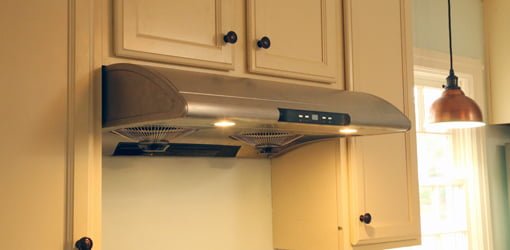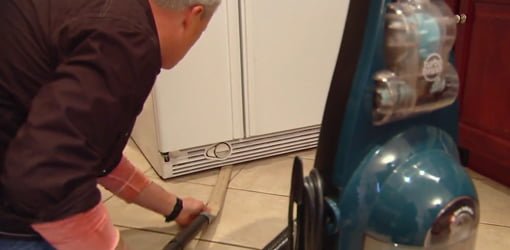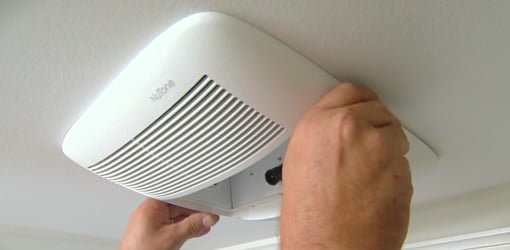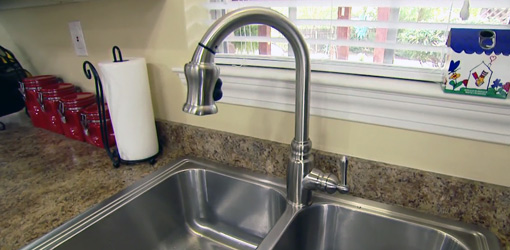[ad_1]
You’ve checked everything off your spring cleaning to-do list. Your floors are spotless, closets decluttered, and ceiling fans dust-free.
But, here are five areas of your home that you’re likely neglecting to clean, which could be affecting your family’s health and your wallet.
The range hood filter is probably the most overlooked area in the kitchen. Its job is to exhaust grease, smoke and other toxins from the kitchen to the outdoors, leaving behind cleaner air. It’s important to clean a kitchen range hood filter to remove grease and grime that can make the fan less effective and shorten the fan’s life.
Soak metal filters in hot, soapy water. You can also add a small amount of degreaser or ammonia to the water to help breakdown stubborn build-up. Wipe down the exterior and underside of the range hood with a sponge and soapy water to cut through the grease.
Watch Range Hood Filter Cleaning Tips for details.

When is the last time you peeked BEHIND your fridge? You’d be amazed at the amount of dust that finds it way underneath and behind your refrigerator. A buildup of dust and lint causes your refrigerator to work harder, so keeping the condenser coils free of debris allows it to run more efficiently.
First, be sure to unplug the refrigerator or turn off the power at the breaker before cleaning these areas. Pull the refrigerator away from the wall and vacuum behind and underneath. Or, make a vacuum cleaner attachment from a cardboard gift wrap tube, and use it to clean under the refrigerator. After removing the protective grate in front of the cooling coils, gently scrub the coils with a stiff brush and use a vacuum attachment to remove the lint and dust.
Gaskets ensure the refrigerator doors seal tightly, but if they’re full of gunk, they can’t do their job effectively. Spray the gaskets with a citrus cleaner and wipe with a damp cloth. Regular cleaning will help keep the refrigerated air where it should be.
Watch Tips to Keep Your Kitchen Clean for more info.

Where’s that smell coming from? Unless you’ve sanitized and deodorized your disposal lately, it’s the likely culprit.
Pour 1/2 cup of baking soda, followed by 1 cup of vinegar, in the disposal. Allow the baking soda and vinegar to react. After the bubbling subsides, pour a pot of boiling water down the garbage disposal. Let sit for 5 minutes. Then turn on the cold water tap and run the disposal to flush it out.
And, here’s another method: Pour crushed ice into the disposal to clean the blades, and throw in lemon or lime rinds to deodorize.
Check out How to Clean the Garbage Disposal in Your Kitchen and Top 5 Tips to Keep Your Garbage Disposal Running Right for more info.

A bathroom vent fan removes excess moisture that can lead to mold and mildew and poor air quality in your home. As air is drawn through the fan, dust builds up on the grille cover and the fan motor over time.
Remove the cover and use a vacuum cleaner with a brush attachment to clean the cover and grille. Use a crevice tool attachment to remove dirt and debris from inside the fan housing, being careful not to damage the fan. If the fan is noisy, lubricate it with a silicone spray before replacing the cover.
Watch Bathroom Ventilation Fan Cleaning Tips and How to Maintain a Bathroom Vent Fan for details.

Any time you fill your glass with water or brush your teeth, the water passes through an aerator.
Aerators contain a fine wire screen that mixes water with air to provide an even flow. Over time this screen can become clogged with mineral deposits or debris, reducing the amount of water coming through.
Unscrew the aerator from the end of the faucet, and soak it overnight in a cup of white vinegar. The acid in the vinegar will dissolve any deposits and make the aerator as good as new.
Watch Cleaning a Faucet Aerator for more info.
[ad_2]
Source link

